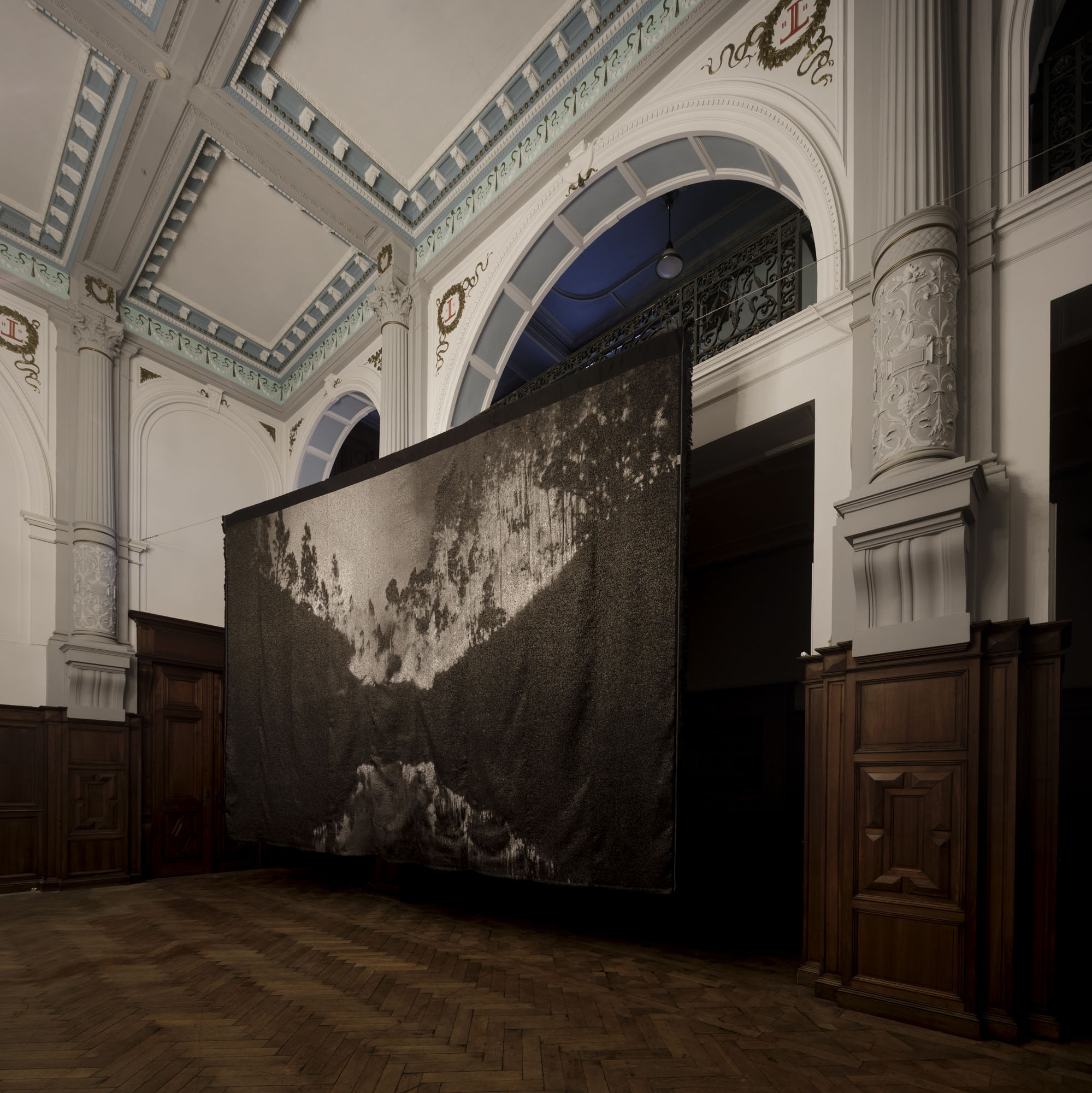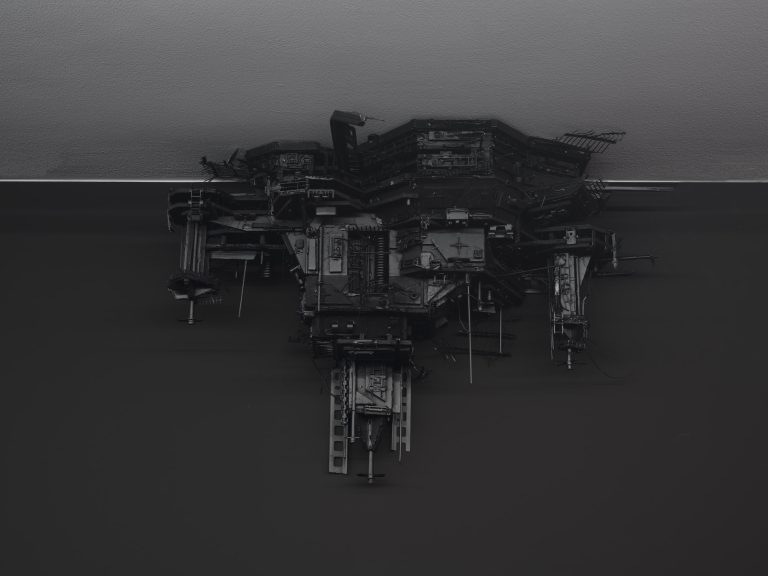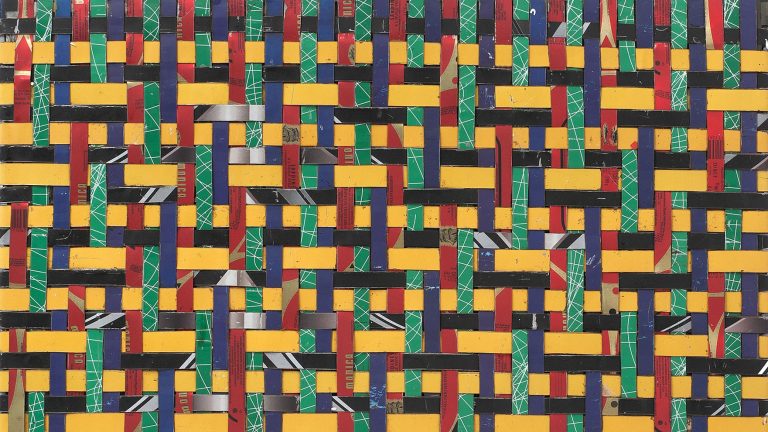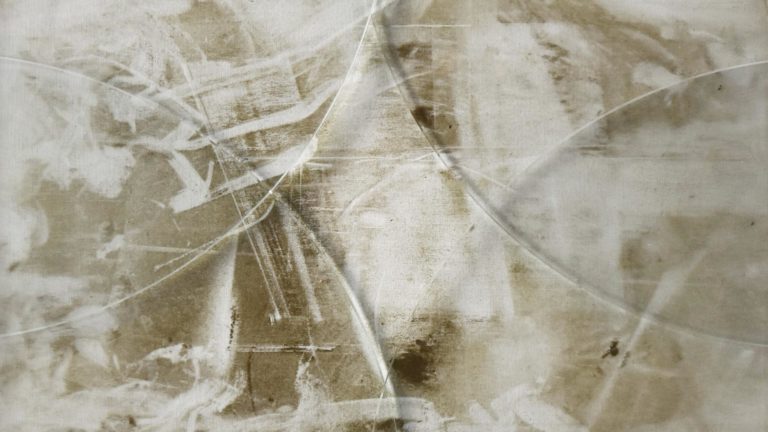Artist: Antonio Vega Macotela
Exhibition title: Incendio
Venue: CIAP, Hasselt, Belgium
Date: October 6 – December 8, 2019
Photography: Michiel De Cleene / all images copyright and courtesy of the artist and CIAP, Hasselt
‘Underground’, ’undermine’, ‘loophole’, and ‘subvert’ – it seems no coincidence that the language we use to describe any anti-establishment practices have something to do with being under the surface and not being seen. The parallel is not only linguistic; from subterranean headquarters to underground vaults, to illegal mines – the space under the radar is the most interesting one; it is where villains and vigilantes work side by side.
Antonio Vega Macotela is fascinated by those kinds of insurgent practices which, throughout history, have opposed systems of exploitation by redistributing resources and creating alter-native value systems. In his long-term project, The Q’aquchas Ballade, Macotela engages with the history of the pirate-miners, the titular Q’aquchas. Active in colonial Bolivia, in the 18th-century, they were infamous for illegally exploiting the mines, at times when legitimate miners were obliged to rest. At night, on week-ends and holidays, the tunnels resounded with loud ‘q’aquchas’; remarkably, the word itself is also an onomatopoeia for the sound of metal hit-ting against stone. Every culture has their heroic outlaw, their Robin Hood, Ned Kelly, or Juro Jánošík, and the Q’aquchas can be seen as that kind of collective folk hero, reclaiming and redistributing the resources usurped by the colonial oppressors.
Macotela has been researching the history of the Q’aquchas for several years now; the Potosi silver mines were the setup for his Study of Exhaustion — The Equivalent of Silver (2011) presented during Manifesta 9 in Genk (2012). In his contribution to Documenta 14 in Kassel, Macotela took as a starting point the dreadful history of the Mill of Blood (2017) in Bolivia, which used power of Indigenous slaves for minting coins from locally mined silver.
In his new project, Macotela draws a parallel between the Q’aquchas and the powerful, nomadic hackers’ groups, led by Nos del Abismo, with whom Macotela managed to establish contact and enter into collaboration. In times when the most valuable resource is no longer coal or oil but data, they are the contemporary pirates, the agents of political, social, and economic disruption. Whether mining for coal or data, both groups have successfully exploited loopholes to undermine the existing power structures and ‘hack’ the system. Through this transhistorical approach, The Q’aquchas Ballade explores different narratives of resistance and strategies of subversion.
The solo-exhibition Incendio (‘fire’) focuses on the first chapter of the Ballade, comprising a series of seven monumental tapestries with images of wildfires, of which two are being exhibited at CIAP. These images have been pulled from the Internet and transformed into textiles using Jacquard looms. In transforming each pixel into a unit of yarn, Macotela demonstrates the affinity between the construction of digital images and textiles. This is not the end of the parallels between the two; the historical development of coding and weaving technologies partly overlap, for example, both had made use of the ‘punched cards’ – pieces of stiff, perforated paper used to contain digital data in an analogue format.
Macotela’s tapestries also serve as a data-storage of a kind. The artist ‘encoded’ them with information coming from the so-called ‘Lagarde list’, a document disclosing the names of two thou-sand purported tax evaders of Greek nationality and a subset of the ‘Falciani list’, considered the biggest leak in banking history. The list was revealed in 2010, at the onset of the Greek crisis, and stirred up international controversy. The initial unwillingness of the authorities to prose-cute the elites and the subsequent expiration of charges revealed the entanglement of politics in the global black money circulation. Macotela has been particularly fascinated by the figure of the whistleblower responsible for the leak and his ambiguous motifs and methods.
The artist appropriated the technique of ‘steganography’, commonly used by hackers and activists to hide secret information in an ordinary file, to encode data into the images of wildfires. In digital steganography, information is stored in slight variations of colour or brightness, im-perceptible to the human eye. Those aberrations, purposely exaggerated by the artist, account for the golden tones within the tapestries.
The recurring motif of the wildfire can be considered the artist’s response to the historical genre of landscape painting. Himself trained as a painter, Macotela is well aware of the politics of landscape, epitomised by the marriage of the 19th-century nationalism and Romanticism. The burning forest marks the timely death of the traditional landscape and the symbolic structures it stood for. In the era of data warfare, where the country borders pose no obstacle for the information flow, the hegemony of nation-states gave place to the interplay between corporate and state powers. Even though most of contemporary financial and informational operations remain invisible, they still have palpable effects on our landscape (the realisation of the work coincided strikingly with the natural catastrophe in the Amazon). This loaded invisibility resonates in the title of the series, Nobody will believe the fire if its smoke does not send signals, which is a quote from the poem Incendio by sister Juana Ines de la Cruz, a Mexican poet of the Q’aquchas.
Salgan signos a la boca
de lo que el corazón arde,
que nadie, nadie creerá el
incendio si el humo no da señales
May signs come out of my mouth
of how much my heart burns,
Because nobody, nobody will believe a
fire if its smoke does not send signals
– excerpt from Incendio by Sister Juana Ines de la Cruz (1648-1695)
Antonio Vega Macotela (°1980) is a multi-disciplinary artist based between Amsterdam and Mexico. He was an artist-in-residence in a number of international programmes, amongst others at the Rijksakademie, Amsterdam; Le Pa-villon at Palais de Tokyo, Paris; and Intermedia Artist in Residence programme, at the Parsons School of Art, Media and Technology, New York. His works have been exhibited internationally, most recently in Stories of almost everyone at the Hammer Museum in Los Angeles (2018) and during Documenta 14 in Kassel and Athens (2017). He participated in the13th Istanbul Biennial (2013), in Manifesta 9 (Genk, 2012), and the 29th Sao Paulo Biennial (2010). Macotela has been selected for the upcoming Sao Paulo Biennial.
In collaboration with FLACC workshop for visual artists (Genk) and in the context of Stadstriënnale Screen-it. With the kind support of: Labor Gallery Mexico, Flemish Community, the City of Hasselt and the City of Genk, and the CIAP members.















